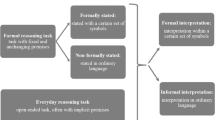Abstract
One of the mechanisms that a student of Prolog must learn to understand and to use is unification. Initially students have only a partial understanding of unification and therefore they are not able to fully understand the execution of a program. This paper shows that a considerable part of the errors that students make can be explained by an impaired version of the correct algorithm. The changes from the correct algorithm to the false algorithms can be justified by a psychologically plausible mechanism.
Similar content being viewed by others
References
Bratko, I. (1986). Prolog programming for artificial intelligence. Reading MA: Addison-Wesley.
Brown, J. S. and VanLehn, K. (1980). Repair theory: a generative theory of bugs in a procedural skill. Cognitive Science, 4, pp. 379–426.
Clocksin, W. and Mellish, C. (1981)., Programming in Prolog. Berlin: Springer Verlag.
Quast, J. (1986). DIABUG een computerprogramma voor de automatische diagnose van Prolog unifikatiefouten. Report Psy.26.6.86.109, Department of Experimental Psychology, University of Amsterdam.
Norman, D. (1981). Categorization of action slips. Psychological Review, 88, 1–15.
Sleeman, D. (1984). Mis-generalization: an explanation of observed mal-rules. In Proceedings of the Sixth Annual Cognitive Science Conference, Boulder, pp. 51–56.
van Someren, M. W. (1990). What's wrong? Understanding beginners' problems with Prolog. Instructional Science, this volume.
Taylor, J. (1984). Why novices will find learning Prolog hard. In Proceedings of the European Conference on Artificial Intelligence 1984, Pisa.
Taylor, J. and du Boulay, B. (1986). Studying novice programmers: why they may find learning Prolog hard. In J. Rutkowska (Ed.), Issues for developmental psychology. New York: Wiley.
Author information
Authors and Affiliations
Rights and permissions
About this article
Cite this article
Van Someren, M.W. Understanding students' errors with Prolog unification. Instr Sci 19, 361–376 (1990). https://doi.org/10.1007/BF00116445
Issue Date:
DOI: https://doi.org/10.1007/BF00116445




